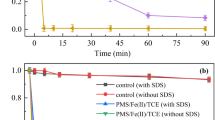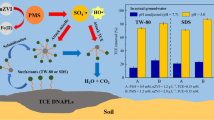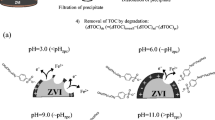Abstract
Anionic surfactant wastewater has an irreversible effect on aquatic animals and plants. In this paper, the oxidation of sodium dodecylbenzene sulfonate (SDBS) by electro-Fenton system was researched. The results demonstrated that HO2· had a weak ability to oxidize SDBS; ·OH was the primary active substance for oxidizing SDBS. The broken bond sites of SDBS molecules oxidized by the active substances were analyzed by using the concept density functional theory. The calculation results indicated that ·OH initially attacked the C3-C11 bond in the SDBS molecule, and then ·OH underwent addition reactions, forming two typical structures: aromatic sodium p-hydroxybenzene sulfonate and aliphatic linear alkanes. Phenol and sodium dodecyl sulfate (SDS) were selected to study their oxidation behaviors in the electro-Fenton system. It can reflect the oxidation process of the products after the SDBS molecule was broken. The main active substance for oxidizing phenol in the electro-Fenton cathode chamber was ·OH, but the main active substance for oxidizing SDS was HO2·. Unlike the ·OH produced by the cathode, the Pt(·OH) produced by the anode had no effect on the removal of SDBS. Nevertheless, Pt(·OH) exhibited an excellent oxidation effect on SDBS bond-breaking products. The research results clarified the mechanisms of SDBS oxidation in electro-Fenton system and the direction of regulation for the reaction path. It is believed that promoting the ·OH generated at the cathode makes SDBS bond breakage a key step in the electro-Fenton oxidation of SDBS. It provided a theoretical basis for enhancing the current efficiency of the system.






Similar content being viewed by others
Data Availability
All data generated or analyzed during this study are included in this published article.
References
Adak, A., Bandyopadhyay, M., & Pal, A. (2005). Removal of anionic surfactant from wastewater by alumina: A case study. Colloids and Surfaces a: Physicochemical and Engineering Aspects, 254, 165–171.
Babuponnusami, A., & Muthukumar, K. (2012). Advanced oxidation of phenol: A comparison between Fenton, electro-Fenton, sono-electro-Fenton and photo-electro-Fenton processes. Chemical Engineering Journal, 183, 1–9.
Chen, S., Zheng, H., Shen, C., Jiang, B., Liu, F., & Li, A. (2021). Hierarchical iron phosphides composite confined in ultrathin carbon layer as effective heterogeneous electro-Fenton catalyst with prominent stability and catalytic activity. Advanced Functional Materials, 31(48), 2106311.
Da Silva, L. M., De Faria, L. A., & Boodts, J. F. C. (2002). Electrochemical impedance spectroscopic (EIS) investigation of the deactivation mechanism, surface and electrocatalytic properties of Ti/RuO2(x)+Co3O4(1–x) electrodes. Journal of Electroanalytical Chemistry, 532(1–2), 141–150.
Fierro, S., Nagel, T., Baltruschat, H., & Comninellis, C. (2007). Investigation of the oxygen evolution reaction on Ti/IrO2 electrodes using isotope labelling and on-line mass spectrometry. Electrochemistry Communications, 9(8), 1969–1974.
Fourcade, F., Delawarde, M., Guihard, L., Nicolas, S., & Amrane, A. (2013). Electrochemical reduction prior to electro-Fenton oxidation of azo dyes: Impact of the pretreatment on biodegradability. Water Air and Soil Pollution, 224(1), 1385.
Frisch, M. J., et al. (2016). Gaussian 09, Revision D.01, Gaussian. Inc, Wallingford CT.
Ganiyu, S. O., Araujo, M. J. G. D., Costa, E. C. T. D., Santos, J. E. L., Santos, E. V. D., & Pergher, S. B. C. (2021). Design of highly efficient porous carbon foam cathode for electro-Fenton degradation of antimicrobial sulfanilamide. Applied Catalysis b: Environmental, 283, 119652.
Ghanim, A. N. (2016). Application of Taguchi method for electro-Fenton degradation of SDBS anionic surfactant[J]. Global NEST Journal, 18(1), 79–88.
Gu, Y., Qiu, Y., Hua, X., Shi, Z., Li, A., Ning, Y., & Liang, D. (2021). Critical biodegradation process of a widely used surfactant in the water environment: Dodecyl benzene sulfonate (DBS). RSC Advance, 11(33), 20303–20312.
Gupta, S., Pal, A., Ghosh, P. K., & Bandyopadhyay, M. (2003). Performance of waste activated carbon as a low-cost adsorbent for the removal of anionic surfactant from aquatic environment. Journal of Environmental Science and Health, Part A, 38, 381–397.
He, H., & Zhou, Z. (2017). Electro-Fenton process for water and wastewater treatment. Critical Reviews in Environmental Science and Technology, 47(21), 2100–2131.
Jojoa-Sierra, S. D., Silva-Agredo, J., Herrera-Calderon, E., & Torres-Palma, R. A. (2017). Elimination of the antibiotic norfloxacin in municipal wastewater, urine and seawater by electrochemical oxidation on IrO2 anodes. Science of the Total Environment, 575, 1228–1238.
Joo, J. Y., Lee, J. K., Kwon, Y., Jung, C. R., Lee, E. S., Jiang, J. H., Lee, H. J., Uhm, S., & Lee, J. (2010). Enhancement of CO tolerance on electrodeposited Pt anode for micro-PEM fuel cells. Fuel Cells, 10(6), 926–931.
Lee, C. T., Yang, W. T., & Parr, R. G. (1988). Development of the Colle-Salvetti correlation-energy formula into a functional of the electron density. Physical Review B, 37(2), 785–789.
Li, H., Jiang, H., Liu, C., Zhu, C., & Zhu, X. (2019). Electrochemical oxidation of sulfonamides with boron-doped diamond and Pt anodes. ChemistryOpen, 8(12), 1421.
Li, B., Sun, J. D., Tang, C., Yan, Z. Y., Zhou, J., Wu, X. Y., Jia, H. H., & Yong, X. Y. (2021a). A novel core-shell Fe@Co nanoparticles uniformly modified graphite felt cathode (Fe@Co/GF) for efficient bio-electro-Fenton degradation of phenolic compounds. Science of the Total Environment, 760, 143415.
Li, X., Yan, J., & Zhu, K. (2021b). Effects of IrO2 interlayer on the electrochemical performance of Ti/Sb-SnO2 electrodes. Journal of Electroanalytical Chemistry, 878, 114471.
Lin, H., Zhang, H., Wang, X., Wang, L., & Wu, J. (2014). Electro-Fenton removal of Orange II in a divided cell: Reaction mechanism, degradation pathway and toxicity evolution. Separation and Purification Technology, 122, 533–540.
Lu, T., & Chen, F. (2012). Multiwfn: A multifunctional wavefunction analyzer. Journal of Computational Chemistry, 33(5), 580–592.
Martinez-Huitle, C. A., & Ferro, S. (2006). Electrochemical oxidation of organic pollutants for the wastewater treatment: Direct and indirect processes. Chemical Society Reviews, 35(12), 1324–1340.
Panizza, M., Barbucci, A., Delucchi, M., Carpanese, M. P., Giuliano, A., Cataldo-Hernandez, M., & Cerisola, G. (2013). Electro-Fenton degradation of anionic surfactants. Separation and Purification Technology, 118, 394–398.
Raghavachari, K. (2000). Perspective on “Density functional thermochemistry. III. The role of exact exchange” - Becke AD (1993) J Chem Phys 98:5648–52. Theoretical Chemistry Accounts, 103(3–4), 361–363.
Scott, M., & Walker, R. (2002). Addition of toluene and ethylbenzene to mixtures of H2 and O2 at 773 K - Part I: Kinetic measurements for H and HO2 reactions with the additives and a data base for H abstraction by HO2 from alkanes, aromatics and related compounds. Combustion and Flame, 129(4), 365–377.
Sfahlan, A. J., Mahmoodzadeh, A., Hasanzadeh, A., Heidari, R., & Jamei, R. (2009). Antioxidants and antiradicals in almond hull and shell (Amygdalus communis L.) as a function of genotype. Food Chemistry, 115(2), 529–533.
Silva, L. M., dos Santos, R. P. A., Morais, C. C. O., Vasconcelos, C. L., Martinez-Huitle, C. A., & Castro, S. S. L. (2017). Anodic oxidation of the insecticide imidacloprid on mixed metal oxide (RuO2-TiO2 and IrO2-RuO2-TiO2) anodes. Journal of the Electrochemical Society, 164(13), E489–E495.
Sires, I., Oturan, N., Oturan, M. A., Rodriguez, R. M., Garrido, J. A., & Brillas, E. (2007). Electro-Fenton degradation of antimicrobials triclosan and triclocarban. Electrochimica Acta, 52(17), 5493–5503.
Sires, I., Brillas, E., Oturan, M. A., Rodrigo, M. A., & Panizza, M. (2014). Electrochemical advanced oxidation processes: Today and tomorrow A review. Environmental Science and Pollution Research, 21(14), 8336–8367.
Sun, X., Pan, G., Qi, H., & Sun, Z. (2020). Dip-coating prepared nickel-foam composite cathodes with hydrophobic layer for atenolol elimination in electro-Fenton system. Journal of Electroanalytical Chemistry, 856, 113725.
Taher, A. M., & Cates, D. M. (1975). Bleaching cellulose (I): A free radical mechanism. Textile Chemist & Colorist, 7(12), 30–34.
Thompson, K. M., Griffith, W. P., & Spiro, M. (1993). Mechanism of bleaching by peroxides (1): Kinetics of bleaching of phenolphthalein by hydrogen peroxide at high pH. Journal of the Chemical Society, Faraday Transactions, 89, 1203–1209.
Turkten, N., & Cinar, Z. (2017). Photocatalytic decolorization of azo dyes on TiO2: Prediction of mechanism via conceptual DFT. Catalysis Today, 287, 169–175.
Vos, A. M., Nulens, K. H. L., De Proft, F., Schoonheydt, R. A., & Geerlings, P. (2002). Reactivity descriptors and rate constants for electrophilic aromatic substitution: Acid zeolite catalyzed methylation of benzene and toluene. Journal of Physical Chemistry B, 106(8), 2026–2034.
Wang, Z., Zhao, H., Qi, H., Liu, X., & Liu, Y. (2019). Free radical behaviours during methylene blue degradation in the Fe2+/H2O2 system. Environmental Technology, 40(9), 1138–1145.
Weiss, E., Groenen-Serrano, K., & Savall, A. (2006). Electrochemical degradation of sodium dodecylbenzene sulfonate on boron doped diamond and lead dioxide anodes. Journal of New Materials for Electrochemical Systems, 9, 249–256.
Weiss, E., Groenen-Serrano, K., & Savall, A. (2007). Electrochemical mineralization of sodium dodecylbenzenesulfonate at boron doped diamond anodes. Journal of Applied Electrochemistry, 37(11), 1337–1344.
Yan, S. (2020). Effect and mechanism of nitrogen-doped carbon nanotubes activated persulfate to degrade phenol. Jilin University. https://doi.org/10.27162/d.cnki.gjlin.2020.002968
Yang, Y., Zheng, M., Qiao, S., Zhou, J., Bi, Z., & Quan, X. (2022). Electro-Fenton improving fouling mitigation and microalgae harvesting performance in a novel membrane photobioreactor. Water Research, 210, 117955.
Yu, F., Wang, Y., & Ma, H. (2019). Enhancing the yield of H2O2 from oxygen reduction reaction performance by hierarchically porous carbon modified active carbon fiber as an effective cathode used in electro-Fenton. Journal of Electroanalytical Chemistry, 838, 57–65.
Zhang, T. Y., Oyama, T., Horikoshi, S., Zhao, J. C., Serpone, N., & Hidaka, H. (2003). Photocatalytic decomposition of the sodium dodecylbenzene sulfonate surfactant in aqueous titania suspensions exposed to highly concentrated solar radiation and effects of additives. Applied Catalysis b: Environmental, 42, 13–24.
Zhao, H., Dong, M., Wang, Z., Wang, H., & Qi, H. (2020). Roles of free radicals in NO oxidation by Fenton system and the enhancement on NO oxidation and H2O2 utilization efficiency. Environmental Technology, 41(1), 109–116.
Funding
This work was supported by the Science Foundation of Northeast Petroleum University (SJQHB202003, 2018GPQZ-09).
Author information
Authors and Affiliations
Contributions
All authors contributed to the study conception and design. Material preparation, data collection, and analysis were performed by Xuejia Wang, Xue Yang, and Mingqi He. The first draft of the manuscript was written by Peng Yan, and all authors commented on previous versions of the manuscript. All authors read and approved the final manuscript.
Corresponding authors
Ethics declarations
Conflict of Interest
The authors declare no competing interests.
Additional information
Publisher's Note
Springer Nature remains neutral with regard to jurisdictional claims in published maps and institutional affiliations.
Rights and permissions
Springer Nature or its licensor (e.g. a society or other partner) holds exclusive rights to this article under a publishing agreement with the author(s) or other rightsholder(s); author self-archiving of the accepted manuscript version of this article is solely governed by the terms of such publishing agreement and applicable law.
About this article
Cite this article
Wang, X., Yan, P., Yang, X. et al. Study on the Mechanism of Sodium Dodecylbenzene Sulfonate Oxidation by Electro-Fenton System. Water Air Soil Pollut 233, 462 (2022). https://doi.org/10.1007/s11270-022-05944-8
Received:
Accepted:
Published:
DOI: https://doi.org/10.1007/s11270-022-05944-8




